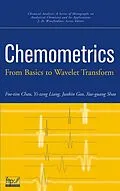Wavelet Transformations and Their Applications in Chemistry
pioneers a new approach to classifying existing chemometric
techniques for data analysis in one and two dimensions, using a
practical applications approach to illustrating chemical examples
and problems. Written in a simple, balanced, applications-based
style, the book is geared to both theorists and
non-mathematicians.
This text emphasizes practical applications in chemistry. It
employs straightforward language and examples to show the power of
wavelet transforms without overwhelming mathematics, reviews other
methods, and compares wavelets with other techniques that provide
similar capabilities. It uses examples illustrated in MATLAB codes
to assist chemists in developing applications, and includes access
to a supplementary Web site providing code and data sets for work
examples. Wavelet Transformations and Their Applications in
Chemistry will prove essential to professionals and students
working in analytical chemistry and process chemistry, as well as
physical chemistry, spectroscopy, and statistics.
Autorentext
FOO-TIM CHAU, PhD, is a Professor in the Department of Applied Biology and Chemical Technology at Hong Kong Polytechnic University.
YI-ZENG LIANG, PhD, is a Professor in the College of Chemistry and Chemical Engineering at Central South University, China.
JUNBIN GAO, PhD, is a Professor in the Department of Mathematics at Huazhong University of Science and Technology. He is currently visiting the University of Southhampton.
XUE-GUANG SHAO, PhD, is a Professor at the University of Science and Technology in China.
Klappentext
All the tools chemists need to analyze chemical data and produce more useful information
The statistical and mathematical methods of chemometrics present a wide array of modeling and processing tools for maximizing useful information from experimental data. These methods both reduce time spent in the laboratory and allow researchers to extract more information from data collected. However, understanding the advanced mathematical background of the latest of these approaches, as well as how to apply them, can still be a time-consuming endeavor for the working chemist.
Chemometrics: From Basics to Wavelet Transform provides a one-stop resource for comprehending the range of available chemometric methods, from basic principles to the theory and practice of wavelet transform. Covering the background of chemometrics, common signal processing techniques, and applications in analytical chemistry, this helpful guide also features:
- Simple language and illustrative examples
- Reviews of other methods in comparison to wavelet techniques
- References to print and online resources
- A companion FTP site with MATLAB® code and data sets
Throughout Chemometrics, the emphasis remains on giving practitioners a useful summary of the latest methods and their real-world applications. Right up to the most modern innovations of wavelet transform, Chemometrics combines timeliness with accessibility to offer chemists, biochemists, and advanced students a vital reference volume.
Zusammenfassung
Wavelet Transformations and Their Applications in Chemistry pioneers a new approach to classifying existing chemometric techniques for data analysis in one and two dimensions, using a practical applications approach to illustrating chemical examples and problems. Written in a simple, balanced, applications-based style, the book is geared to both theorists and non-mathematicians.
This text emphasizes practical applications in chemistry. It employs straightforward language and examples to show the power of wavelet transforms without overwhelming mathematics, reviews other methods, and compares wavelets with other techniques that provide similar capabilities. It uses examples illustrated in MATLAB codes to assist chemists in developing applications, and includes access to a supplementary Web site providing code and data sets for work examples. Wavelet Transformations and Their Applications in Chemistry will prove essential to professionals and students working in analytical chemistry and process chemistry, as well as physical chemistry, spectroscopy, and statistics.
Inhalt
Preface xiii
Chapter 1 Introduction 1
1.1. Modern Analytical Chemistry 1
1.1.1. Developments in Modern Chemistry 1
1.1.2. Modern Analytical Chemistry 2
1.1.3. Multidimensional Dataset 3
1.2. Chemometrics 5
1.2.1. Introduction to Chemometrics 5
1.2.2. Instrumental Response and Data Processing 8
1.2.3. White, Black, and Gray Systems 9
1.3. Chemometrics-Based Signal Processing Techniques 10
1.3.1. Common Methods for Processing Chemical Data 10
1.3.2. Wavelets in Chemistry 11
1.4. Resources Available on Chemometrics and Wavelet Transform 12
1.4.1. Books 12
1.4.2. Online Resources 14
1.4.3. Mathematics Software 15
Chapter 2 One-dimensional Signal Processing Techniques in Chemistry 23
2.1. Digital Smoothing and Filtering Methods 23
2.1.1. Moving-Window Average Smoothing Method 24
2.1.2. Savitsky-Golay Filter 25
2.1.3. Kalman Filtering 32
2.1.4. Spline Smoothing 36
2.2. Transformation Methods of Analytical Signals 39
2.2.1. Physical Meaning of the Convolution Algorithm 39
2.2.2. Multichannel Advantage in Spectroscopy and Hadamard Transformation 41
2.2.3. Fourier Transformation 44
2.2.3.1. Discrete Fourier Transformation and Spectral Multiplex Advantage 45
2.2.3.2. Fast Fourier Transformation 48
2.2.3.3. Fourier Transformation as Applied to Smooth Analytical Signals 50
2.2.3.4. Fourier Transformation as Applied to Convolution and Deconvolution 52
2.3. Numerical Differentiation 54
2.3.1. Simple Difference Method 54
2.3.2. Moving-Window Polynomial Least-Squares Fitting Method 55
2.4. Data Compression 57
2.4.1. Data Compression Based on B-Spline Curve Fitting 57
2.4.2. Data Compression Based on Fourier Transformation 64
2.4.3. Data Compression Based on Principal-Component Analysis 64
Chapter 3 Two-dimensional Signal Processing Techniques in Chemistry 69
3.1. General Features of Two-Dimensional Data 69
3.2. Some Basic Concepts for Two-Dimensional Data from Hyphenated Instrumentation 70
3.2.1. Chemical Rank and Principal-Component Analysis (PCA) 71
3.2.2. Zero-Component Regions and Estimation of Noise Level and Background 75
3.3. Double-Centering Technique for Background Correction 77
3.4. Congruence Analysis and Least-Squares Fitting 78
3.5. Differentiation Methods for Two-Dimensional Data 80
3.6 Resolution Methods for Two-Dimensional Data 81
3.6.1. Local Principal-Component Analysis and Rankmap 83
3.6.2. Self-Modeling Curve Resolution and Evolving Resolution Methods 85
3.6.2.1. Evolving Factor Analysis (EFA) 88
3.6.2.2. Window Factor Analysis (WFA) 90
3.6.2.3. Heuristic Evolving Latent Projections (HELP) 94
Chapter 4 Fundamentals of Wavelet Transform 99
4.1. Introduction to Wavelet Transform and Wavelet Packet Transform 100
4.1.1. A Simple Example: Haar Wavelet 103
4.1.2. Multiresolution Signal Decomposition 108
4.1.3. Basic Properties of Wavelet Function 112
4.2. Wavelet Function Examples 113
4.2.1. Meyer Wavelet 113
4.2.2. B-Spline (Battle--Lemarié) Wavelets 114
4.2.3. Daubechies Wavelets 116
4.2.4. Coiflet Functions 117
4.3. Fast Wavelet Algorithm and Packet Algorithm 118
4.3.1. Fast Wavelet Transform 119
4.3.2.…
